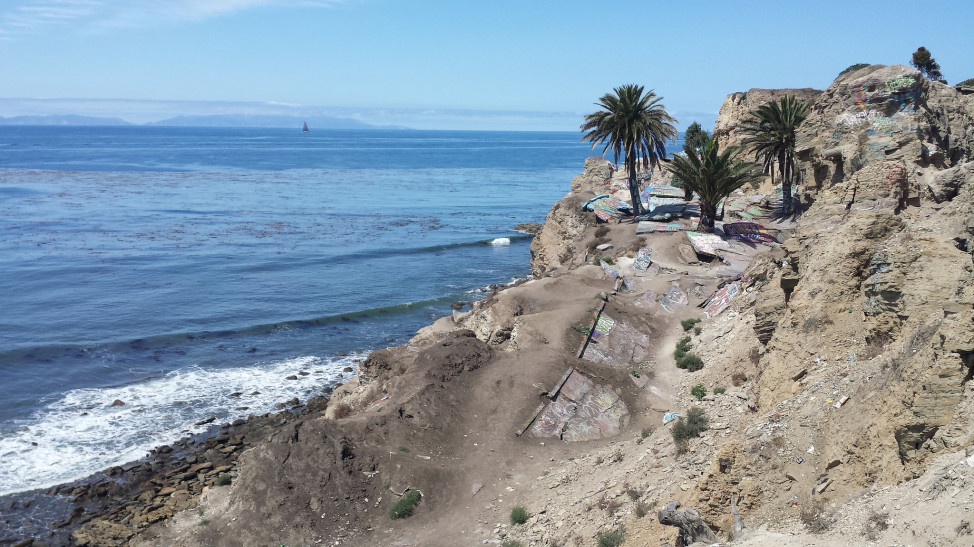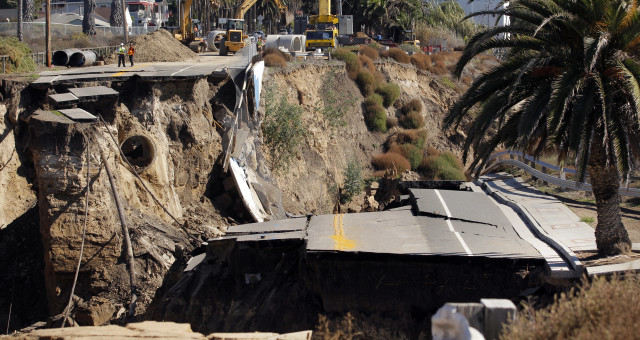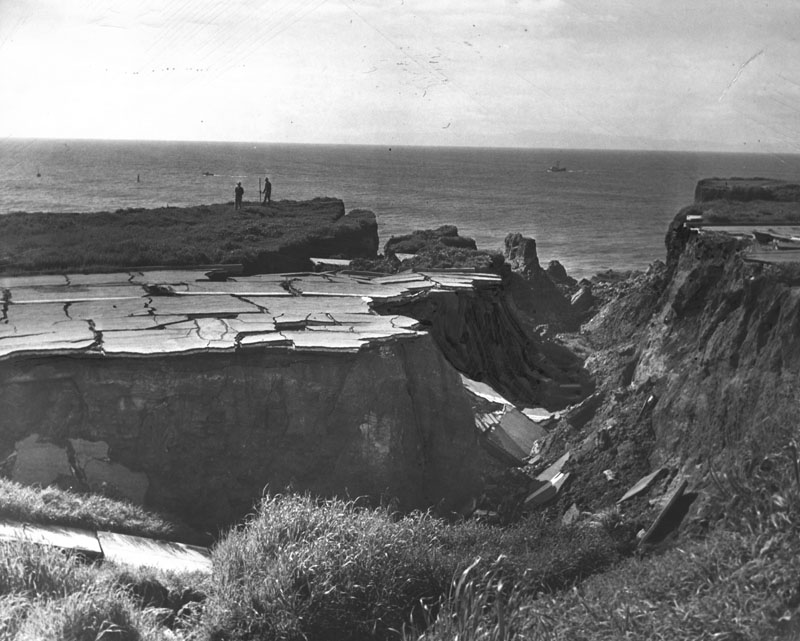
Sunken City, California on July 11, 2015 (Photo by Flickr user Jon May via Creative Commons license.)
In the late 1920s, erosion, slippery clay soil, and a series of landslides sent the tip of a California coastal community sliding into the ocean.
MORE ABOUT AMERICA
Wild West Ghost Town Emerges from Watery Grave
What Happens When Americans Tweet What They Eat
Why Small US Towns Embrace Their Weirdness
Most of the homes in San Pedro overlooking the Pacific were moved before the ocean consumed them, but two bungalows atop the 90-foot bluff, on the seaward side of Paseo Del Mar, did end up toppling into the water. The entire block continued to slide seaward until the mid 1930s.
At its peak, the ground in the Los Angeles coastal community was shifting about 11 inches a day. The area was evacuated and closed to all visitors.
But that slippery history hasn’t kept numerous visitors from ignoring the “No Trespassing” signs and iron gate to enjoy the scenic views. Despite the gate, unauthorized visitors can easily access the area along the coast line.
The houses of Sunken City — as the doomed area came to be known — are long gone, but six acres of buckled roads and sidewalks, along with some water pipes, remain, as does the graffiti left behind by people who’ve frequented the area since.
A Los Angeles councilman recently asked the city to consider reopening the area, 80 years after it was closed off to the public. He proposed adding an automated gate that would let people enter during the day and would automatically lock at night.

In 1929, a sizeable section of land in the southern tip of San Pedro began to slip into the sea. The 600 block of Paseo Del Mar began moving seaward in 1929 and continued to slip until the mid 1930s. (Photo courtesy of the Los Angeles Public Library)

Today, graffiti adorns some of Sunken City’s cliffs and buckled roads, July 11, 2015. (Photo by Flickr user Jon May via Creative Commons license)
“As you are aware, the rich history and scenic views from Sunken City in San Pedro tend to attract many visitors from throughout the region on a daily basis,” Los Angeles City Councilman Joe Buscaino wrote to Michael Shull, director of the Los Angeles Department of Recreation and Parks. “It is one of the only areas along our coastline that remains closed to the public.”
However, Buscaino’s request has not yet met with success.
“The position that the director of the Department of Recreation and Parks has taken is that at this time they are not reopening Sunken City,” said Rose Watson, public information director for the Los Angeles Department of Recreation and Parks. “It’s closed because it’s dangerous.”
There have been a number of safety incidents in the forbidden zone.

A section of a coastal bluff road collapsed in a heavy rainstorm in 2011’s White Point landslide in San Pedro, California. (AP Photo)
Carl Cooper, superintendent of the Pacific Region for the Los Angeles Department of Recreation and Parks, whose jurisdiction includes Sunken City, said unauthorized visitors have suffered from a variety of injuries.
“We’ve had everything from people falling [and] having broken bones,” he said. “We’ve had a number of deaths out there, some by suicide, some by people slipping…sprained ankles to head injuries.”
Stability remains a concern. Cooper points to the 2011 White Point landslide,which occurred within a mile or so of Sunken City, when a 600-foot section of Paseo Del Mar dropped off the cliff.
“There is some areas that could be unstable out there,” Cooper said. “I mean that is an area that did slip, it was a number of years ago, but it has slipped.We know how beautiful it is, we know how people really love that area, but ultimately it’s our responsibility to keep not only the public safe but everybody who wants to enjoy our parks safe.”
Which means that, at least for the time being, Sunken City remains a forbidden — and dangerous — place to visit.

























Big boulders and big chunks of waste concrete should be tossed into those voids to stabilize the area. Later, if it ever stops eroding, new concrete can be poured over the boulders and concrete waste to form a new ground level.
Wow!that sounds creepy,never seen one in East Africa where I come from……
People are strange. When I lived in California in the bay area there were terrible mud slides in 1982 where houses went tumbling down hillsides. These happen periodically. All it took was five days of steady rain. The soil can’t absorb much water and quickly liquefies. View homes are built on stilts and are at high risk for this kind of accident. But people don’t seem to care. They buy them and build them anyway. These were not cheap shacks, they cost up to a million dollars and more. In the North Bay local residents defeated an Army Corps of Engineers plan to execute a mitigation project to prevent some of the mud slides. They said it would ruin the view.
There’s a strange place in Nova Scotia called Peggy’s Cove. It’s a small picturesque fishing village where fishermen set out their lobster traps. It’s full of rocks and little vegetation that makes it look like a moonscape. There’s a jetty made of rocks that projects out from a lighthouse. People go there in bad storms and are swept out to sea. Why? I don’t know but it seems to happen all the time.
I was a bit dissapointed since Suken City seems to be a very beautiful place. However, I agree to forbid the city because people’s safety is the most important thing. I hope the erosion would not happen to many areas so that many people can enjoy the beautiful views of coastlines.